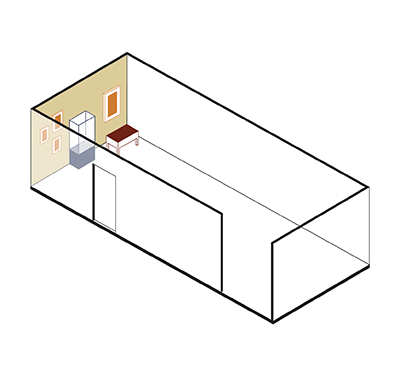ABP 039
Code: ABP 039
Country: Tibet (south)
Style:
Date: 1400
Dimensions in cm WxHxD: 41 x 46
Materials: Glue distemper on cotton
Nine-deity Hevajra Mandala
This mandala represents the celestial abode of the meditation deity Hevajra. At the centre stands the blue yidam, with sixteen arms, four legs and eight faces. In his dynamic walk, he tramples on the corpses of four worldly deities, symbol of his victory over ordinary passions All his hands hold a skull cup, whence his name of Kapaladhara, “the skull holder”. His consort Nairatmya embraces him, holding a chopper and and skull cup. Displayed around the divine couple are eight dancing dakinis of various colours. The outer rim of the mandala consists of the eight great charnel grounds, the ultimate tantric place.
The upper range of the painting displays the Buddhas, Indian and Tibetan masters of the transmission lineage. Various masters and deities are also dispatched outside of the mandala, and the lower rim gathers protective deities, bodhisattvas and a monk presenting offerings. Based on the lineage masters, this painting is clearly associated with the Sakya school of Tibetan Buddhism in which this meditation deity is especially valued and worshipped. Stylistically, the painting displays strong Nepalese influences.
The mandala, “centre and periphery” in Tibetan, is the divine abode of the meditation deity. It represents the complete universe in its pure form. Mandalas are usually geometric two-dimension representations (like a map), but the practitioners always visualize them in volume.
This mandala represents the celestial abode of the meditation deity Hevajra. At the centre stands the blue yidam, with sixteen arms, four legs and eight faces. In his dynamic walk, he tramples on the corpses of four worldly deities, symbol of his victory over ordinary passions All his hands hold a skull cup, whence his name of Kapaladhara, “the skull holder”. His consort Nairatmya embraces him, holding a chopper and and skull cup. Displayed around the divine couple are eight dancing dakinis of various colours. The outer rim of the mandala consists of the eight great charnel grounds, the ultimate tantric place.
The upper range of the painting displays the Buddhas, Indian and Tibetan masters of the transmission lineage. Various masters and deities are also dispatched outside of the mandala, and the lower rim gathers protective deities, bodhisattvas and a monk presenting offerings. Based on the lineage masters, this painting is clearly associated with the Sakya school of Tibetan Buddhism in which this meditation deity is especially valued and worshipped. Stylistically, the painting displays strong Nepalese influences.
The mandala, “centre and periphery” in Tibetan, is the divine abode of the meditation deity. It represents the complete universe in its pure form. Mandalas are usually geometric two-dimension representations (like a map), but the practitioners always visualize them in volume.


